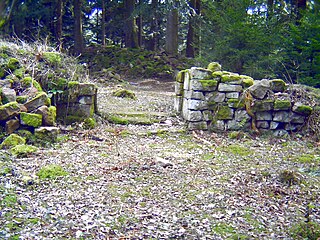
The Willenburg, also called the Schlössle, is a ruined hill castle near Schiltach in the county of Rottweil in the German state of Baden-Württemberg.

A wicket gate, or simply a wicket, is a pedestrian door or gate, particularly one built into a larger door or into a wall or fence.

Amlishagen Castle is a castle near the village of Amlishagen, which is a section of the town of Gerabronn, in the Schwäbisch Hall District of Baden-Württemberg, Germany.

Aizkraukle Castle is a ruined medieval castle, located on the right bank of the river Daugava in Latvia to the west of the modern town of Aizkraukle. The castle was built in the second half of the 14th century by the Livonian Order. From 1334 to 1480 it was the seat of a Komtur.
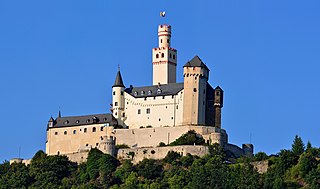
A hill castle or mountain castle is a castle built on a natural feature that stands above the surrounding terrain. It is a term derived from the German Höhenburg used in categorising castle sites by their topographical location. Hill castles are thus distinguished from lowland castles (Niederungsburgen).

Ruine Diepoldsburg is a ruined castle nearby the community of Lenningen, Baden-Württemberg, Germany.

The term lowland castle or plains castle describes a type of castle that is situated on a lowland, plain or valley floor, as opposed to one built on higher ground such as a hill spur. The classification is extensively used in Germany where about 34 percent of all castles are of the lowland type.

A hillside castle is a castle built on the side of a hill above much of the surrounding terrain but below the summit itself. It is thus a type of hill castle and emerged in Europe in the second half of the 11th century. As a result of the particular danger to the site from attacks on the castle from the rising ground above it, this weak point is usually strongly protected by a shield wall or a Bergfried. Often a combination of these two passive defensive works were used.

Liebenzell Castle is a hill castle on a sloping hill spur on the sides of the Schlossberg above the town of Bad Liebenzell in the district of Calw in the south German state of Baden-Württemberg. The fortification was once the most important castle in the Württemberg part of the Black Forest.
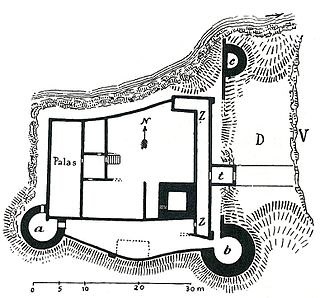
A neck ditch, sometimes called a throat ditch, is a dry moat that does not fully surround a castle, but only bars the side that is not protected by natural obstacles. It is often an important element in the defensive system of hill castles, especially in Germany and other parts of Central Europe.

The Asseburg is a ruined hill castle on the narrow, southern crest of the Asse ridge in the Harz Mountains of Germany, not far from Wolfenbüttel. The castle was built around 1218 by Gunzelin of Wolfenbüttel and his descendants of the House of Asseburg, as a so-called Ganerbenburg, or castle managed and occupied by more than one family or branch. Based on its dimensions, this elongated fortification was the largest hill castle in North Germany and was considered impregnable. Its purpose was to secure the lands around Wolfenbüttel.

Gutenburg Castle, is the ruin of a hill castle above the village of Gutenberg in the county of Bad Kreuznach in the German state of Rhineland-Palatinate.
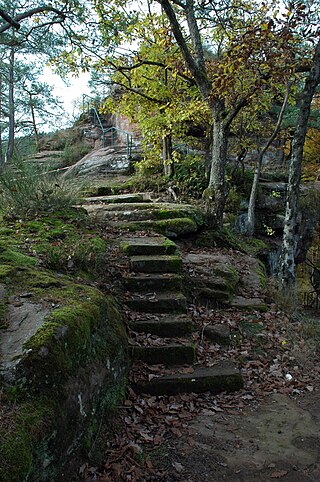
The Wilgartaburg, also called the Wiligartaburg, Wilgartsburg or Wiligartisburg, is the heritage site of a ruined rock castle located at a height of 245 m above sea level (NN) near the German village of Wilgartswiesen in the state of Rhineland-Palatinate.

The Frankenburg is a natural monument with the ruins of a rock castle in the county of Südliche Weinstraße in the German state of Rhineland-Palatinate. It lies above the Modenbach valley on a rocky outcrop of the Frankenberg called the Frankenfelsen and was built to guard the road opposite Meistersel Castle.

Niederalfingen Castle, also called the Marienburg, is a spur castle on a rocky hill spur above the Kocher valley near the village of Niederalfingen in the German state of Baden-Württemberg. It lies within the parish of Hüttlingen in the county of Ostalbkreis.

A Landesburg or landesherrliche Burg was a castle that a territorial lord, such as a prince-bishop, duke or prince built for the defence or expansion of his sovereign estates. They were thus the central and most important castles of the great princely territories. The Landesburgen were usually the property of the territorial lord, but they sometimes referred to castles that he did not own, but were available to him as a safe house (Offenhaus). The large castles of the 8th to 10th centuries, east of the Rhine and outside the towns were often described as Landesburgen because they performed important functions in the control of the state.

Schauenburg Castle is a ruined hilltop castle located in Oberkirch, Germany, atop a 367-metre-high (1,204 ft) (NN) hill spur overlooking the Rench river valley above the town of Gaisbach, Baden-Württemberg. The castle was built by Duke Berthold II of Zähringen.

A chamber gate is a type of gateway system on medieval town fortifications and castles that comprises at least two successive gateways linked by an easily defended passageway between two walls. Chamber gates can be built in the space between two enceintes or built into an enceinte as an independent gateway. Because relatively few fortifications are surrounded by a complete second defensive wall, chamber gates are frequently found in short Zwinger sections.

The ruins of Bärnfels Castle are the remains of a late mediaeval aristocratic castle on the southern edge of the village of Bärnfels in the municipality of Obertrubach in the Upper Franconian county of Forchheim in Bavaria. The ruins of the spur castle are freely accessible.
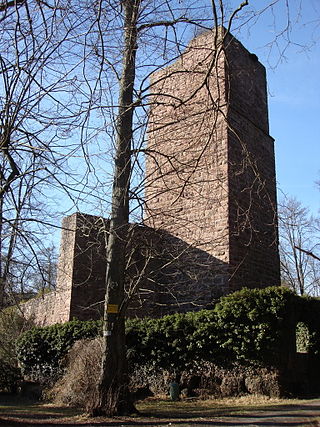
The ruins of Liebeneck Castle were once a high mediaeval spur castle in the southwestern part of the Heckengäu, a forested region southeast of the village of Würm, in the county of Pforzheim in the south German state of Baden-Württemberg.

























